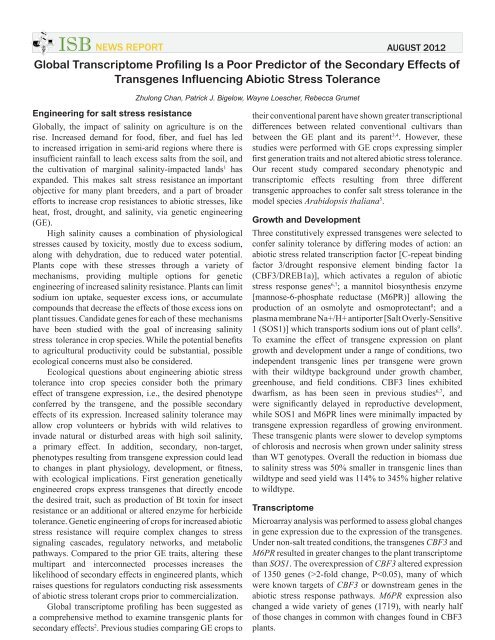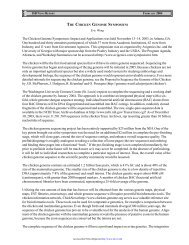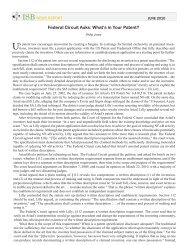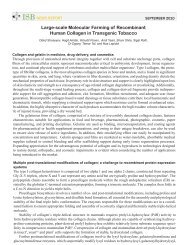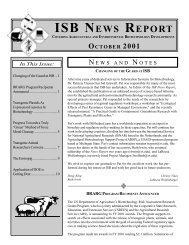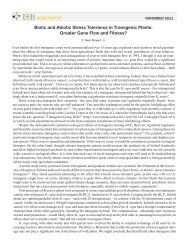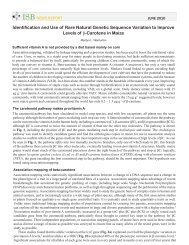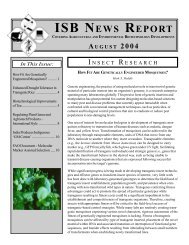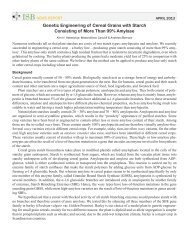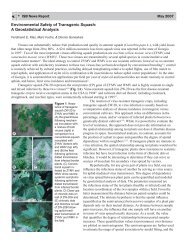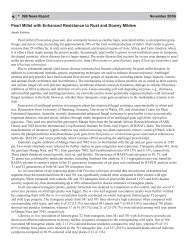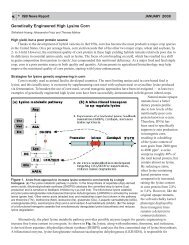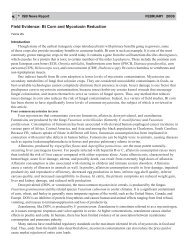Global Transcriptome Profiling Is a Poor Predictor of the Secondary ...
Global Transcriptome Profiling Is a Poor Predictor of the Secondary ...
Global Transcriptome Profiling Is a Poor Predictor of the Secondary ...
Create successful ePaper yourself
Turn your PDF publications into a flip-book with our unique Google optimized e-Paper software.
ISB NEWS REPORT AUGUST 2012<br />
<strong>Global</strong> <strong>Transcriptome</strong> <strong>Pr<strong>of</strong>iling</strong> <strong>Is</strong> a <strong>Poor</strong> <strong>Predictor</strong> <strong>of</strong> <strong>the</strong> <strong>Secondary</strong> Effects <strong>of</strong><br />
Transgenes Influencing Abiotic Stress Tolerance<br />
Zhulong Chan, Patrick J. Bigelow, Wayne Loescher, Rebecca Grumet<br />
Engineering for salt stress resistance<br />
<strong>Global</strong>ly, <strong>the</strong> impact <strong>of</strong> salinity on agriculture is on <strong>the</strong><br />
rise. Increased demand for food, fiber, and fuel has led<br />
to increased irrigation in semi-arid regions where <strong>the</strong>re is<br />
insufficient rainfall to leach excess salts from <strong>the</strong> soil, and<br />
<strong>the</strong> cultivation <strong>of</strong> marginal salinity-impacted lands 1 has<br />
expanded. This makes salt stress resistance an important<br />
objective for many plant breeders, and a part <strong>of</strong> broader<br />
efforts to increase crop resistances to abiotic stresses, like<br />
heat, frost, drought, and salinity, via genetic engineering<br />
(GE).<br />
High salinity causes a combination <strong>of</strong> physiological<br />
stresses caused by toxicity, mostly due to excess sodium,<br />
along with dehydration, due to reduced water potential.<br />
Plants cope with <strong>the</strong>se stresses through a variety <strong>of</strong><br />
mechanisms, providing multiple options for genetic<br />
engineering <strong>of</strong> increased salinity resistance. Plants can limit<br />
sodium ion uptake, sequester excess ions, or accumulate<br />
compounds that decrease <strong>the</strong> effects <strong>of</strong> those excess ions on<br />
plant tissues. Candidate genes for each <strong>of</strong> <strong>the</strong>se mechanisms<br />
have been studied with <strong>the</strong> goal <strong>of</strong> increasing salinity<br />
stress tolerance in crop species. While <strong>the</strong> potential benefits<br />
to agricultural productivity could be substantial, possible<br />
ecological concerns must also be considered.<br />
Ecological questions about engineering abiotic stress<br />
tolerance into crop species consider both <strong>the</strong> primary<br />
effect <strong>of</strong> transgene expression, i.e., <strong>the</strong> desired phenotype<br />
conferred by <strong>the</strong> transgene, and <strong>the</strong> possible secondary<br />
effects <strong>of</strong> its expression. Increased salinity tolerance may<br />
allow crop volunteers or hybrids with wild relatives to<br />
invade natural or disturbed areas with high soil salinity,<br />
a primary effect. In addition, secondary, non-target,<br />
phenotypes resulting from transgene expression could lead<br />
to changes in plant physiology, development, or fitness,<br />
with ecological implications. First generation genetically<br />
engineered crops express transgenes that directly encode<br />
<strong>the</strong> desired trait, such as production <strong>of</strong> Bt toxin for insect<br />
resistance or an additional or altered enzyme for herbicide<br />
tolerance. Genetic engineering <strong>of</strong> crops for increased abiotic<br />
stress resistance will require complex changes to stress<br />
signaling cascades, regulatory networks, and metabolic<br />
pathways. Compared to <strong>the</strong> prior GE traits, altering <strong>the</strong>se<br />
multipart and interconnected processes increases <strong>the</strong><br />
likelihood <strong>of</strong> secondary effects in engineered plants, which<br />
raises questions for regulators conducting risk assessments<br />
<strong>of</strong> abiotic stress tolerant crops prior to commercialization.<br />
<strong>Global</strong> transcriptome pr<strong>of</strong>iling has been suggested as<br />
a comprehensive method to examine transgenic plants for<br />
secondary effects 2 . Previous studies comparing GE crops to<br />
<strong>the</strong>ir conventional parent have shown greater transcriptional<br />
differences between related conventional cultivars than<br />
between <strong>the</strong> GE plant and its parent 3,4 . However, <strong>the</strong>se<br />
studies were performed with GE crops expressing simpler<br />
first generation traits and not altered abiotic stress tolerance.<br />
Our recent study compared secondary phenotypic and<br />
transcriptomic effects resulting from three different<br />
transgenic approaches to confer salt stress tolerance in <strong>the</strong><br />
model species Arabidopsis thaliana 5 .<br />
Growth and Development<br />
Three constitutively expressed transgenes were selected to<br />
confer salinity tolerance by differing modes <strong>of</strong> action: an<br />
abiotic stress related transcription factor [C-repeat binding<br />
factor 3/drought responsive element binding factor 1a<br />
(CBF3/DREB1a)], which activates a regulon <strong>of</strong> abiotic<br />
stress response genes 6,7 ; a mannitol biosyn<strong>the</strong>sis enzyme<br />
[mannose-6-phosphate reductase (M6PR)] allowing <strong>the</strong><br />
production <strong>of</strong> an osmolyte and osmoprotectant 8 ; and a<br />
plasma membrane Na+/H+ antiporter [Salt Overly-Sensitive<br />
1 (SOS1)] which transports sodium ions out <strong>of</strong> plant cells 9 .<br />
To examine <strong>the</strong> effect <strong>of</strong> transgene expression on plant<br />
growth and development under a range <strong>of</strong> conditions, two<br />
independent transgenic lines per transgene were grown<br />
with <strong>the</strong>ir wildtype background under growth chamber,<br />
greenhouse, and field conditions. CBF3 lines exhibited<br />
dwarfism, as has been seen in previous studies 6,7 , and<br />
were significantly delayed in reproductive development,<br />
while SOS1 and M6PR lines were minimally impacted by<br />
transgene expression regardless <strong>of</strong> growing environment.<br />
These transgenic plants were slower to develop symptoms<br />
<strong>of</strong> chlorosis and necrosis when grown under salinity stress<br />
than WT genotypes. Overall <strong>the</strong> reduction in biomass due<br />
to salinity stress was 50% smaller in transgenic lines than<br />
wildtype and seed yield was 114% to 345% higher relative<br />
to wildtype.<br />
<strong>Transcriptome</strong><br />
Microarray analysis was performed to assess global changes<br />
in gene expression due to <strong>the</strong> expression <strong>of</strong> <strong>the</strong> transgenes.<br />
Under non-salt treated conditions, <strong>the</strong> transgenes CBF3 and<br />
M6PR resulted in greater changes to <strong>the</strong> plant transcriptome<br />
than SOS1. The overexpression <strong>of</strong> CBF3 altered expression<br />
<strong>of</strong> 1350 genes (>2-fold change, P
ISB NEWS REPORT AUGUST 2012<br />
In M6PR lines, however, not only were abiotic stress<br />
response genes affected, but also pathogen and oxidative<br />
stress related genes. SOS1 had <strong>the</strong> lowest number <strong>of</strong><br />
changes in transcript level (619) <strong>of</strong> <strong>the</strong> three transgenes,<br />
but its expression did result in significant down-regulation<br />
<strong>of</strong> oxidative stress responsive genes. Very few expression<br />
changes occurred in common for all three transgenes.<br />
In <strong>the</strong> presence <strong>of</strong> salinity stress, wildtype lines WS and<br />
Col had a large number <strong>of</strong> transcripts with altered expression<br />
levels (1093 and 2552 respectively), while <strong>the</strong> number <strong>of</strong><br />
transcripts affected by salt stress in <strong>the</strong> transgenic lines<br />
was significantly lower (between 100-500). There was also<br />
considerable overlap in <strong>the</strong> transcripts induced by salinity<br />
stress in <strong>the</strong> WT lines and those induced by expression <strong>of</strong><br />
<strong>the</strong> transgenes CBF3 and M6PR in <strong>the</strong> absence <strong>of</strong> salt stress<br />
(33% and 47% respectively), suggesting preconditioning by<br />
<strong>the</strong> transgenes for growth under salt stress. Both M6PR and<br />
CBF3 affected approximately 1000 genes under salt stress,<br />
a reduction in transgene effect on gene expression compared<br />
to non-salt stressed conditions. SOS1 affected 845 genes,<br />
but unlike in M6PR and CBF3 lines, this was an increase in<br />
transgene effect from non-salt stressed conditions and <strong>the</strong>re<br />
was little overlap between transcripts affected by salt in WT<br />
and those affected by overexpression <strong>of</strong> SOS1. Also SOS1<br />
plants down-regulated a number <strong>of</strong> pathogen-related genes<br />
when under salinity stress, a difference not observed in nonsalt<br />
treated SOS1 plants or in <strong>the</strong> o<strong>the</strong>r transgenes under<br />
ei<strong>the</strong>r growing condition.<br />
Gene expression and plant performance<br />
Although all three transgenes confer increased salinity<br />
tolerance, <strong>the</strong> effects on plant phenotype, performance,<br />
and transcriptome differed significantly, and varied<br />
depending on <strong>the</strong> presence or absence <strong>of</strong> salinity stress.<br />
The extent <strong>of</strong> transcriptomic change, however, did not<br />
correlate with <strong>the</strong> effect on plant performance (Fig. 1).<br />
For example, <strong>the</strong> greatest phenotypic differences were<br />
observed for CBF3 plants, which had an intermediate<br />
level <strong>of</strong> transcriptomic change. M6PR plants had <strong>the</strong><br />
greatest level <strong>of</strong> transcriptomic change in <strong>the</strong> absence <strong>of</strong><br />
salinity stress, but had little to no change in phenotype<br />
(growth, development, and seed production) in <strong>the</strong> growth<br />
chamber, greenhouse and field. The presence <strong>of</strong> salinity<br />
stress reduced <strong>the</strong> number <strong>of</strong> transcriptional differences<br />
both between <strong>the</strong> CBF3 and M6PR plants, relative to WT,<br />
but increased <strong>the</strong> phenotypic differences. SOS1 plants had<br />
<strong>the</strong> least transcriptomic differences relative to WT, but had<br />
intermediate effects on plant performance in <strong>the</strong> presence <strong>of</strong><br />
salt stress. These results indicate that extensive alterations<br />
in a plant’s transcriptome do not necessarily led to equally<br />
extensive changes in phenotype and performance. This also<br />
has important risk assessment implications for <strong>the</strong> use <strong>of</strong><br />
global transcriptome pr<strong>of</strong>iles to predict secondary effects <strong>of</strong><br />
transgene expression.<br />
Figure 1. Lack <strong>of</strong> relationship between magnitude <strong>of</strong> transcriptional<br />
effects <strong>of</strong> <strong>the</strong> CBF3 (triangles), M6PR (diamonds) and SOS1 (squares)<br />
transgenes and effect <strong>of</strong> <strong>the</strong> transgenes on vegetative (dry weight, black<br />
symbols) and reproductive (seed production, grey symbols) performance<br />
in <strong>the</strong> growth chamber. Open symbols, 0 mM NaCl; closed symbols,<br />
100 mM NaCl. Performance values are averaged over <strong>the</strong> two lines for<br />
each transgene. Magnitude <strong>of</strong> transcriptional effects was number <strong>of</strong> significantly<br />
changed transcript levels for <strong>the</strong> transgenic lines vs. wild type.<br />
Performance difference refers to above-ground dry weight or seed yield<br />
for <strong>the</strong> transgenic lines relative to wild type, expressed as a percent <strong>of</strong><br />
wild type.<br />
Implications for agricultural biotechnology<br />
The lack <strong>of</strong> a predictive link from changes in a plant’s<br />
transcriptome to changes in plant phenotype or performance<br />
has implications for regulators <strong>of</strong> genetically engineered<br />
crops. Transgenic crops are assessed for possible risks,<br />
ranging from human and animal health to <strong>the</strong> environment.<br />
Food safety questions are quantified and measured using<br />
standard toxicological methods, but <strong>the</strong> environmental<br />
concerns are not as easily standardized. The wide range<br />
<strong>of</strong> possible environmental interactions makes <strong>the</strong>se<br />
concerns more difficult to render into testable hypo<strong>the</strong>ses.<br />
However, to assess scientifically <strong>the</strong> environmental risks<br />
from releasing a genetically engineered crop, problem<br />
formulation and risk assessment protocols have been<br />
developed to break <strong>the</strong> environmental risks into <strong>the</strong>ir<br />
component parts; identify <strong>the</strong> possible consequences <strong>of</strong><br />
environmental release; and evaluate <strong>the</strong> probability <strong>of</strong><br />
those consequences occurring 10 .<br />
Thus, for regulators <strong>the</strong> most critical information<br />
relates <strong>the</strong> phenotypic effects <strong>of</strong> transgene expression in
ISB NEWS REPORT AUGUST 2012<br />
a crop to <strong>the</strong> baseline information about that crop and<br />
associated agronomic and environmental factors such<br />
as: cultural practices; related wild species; weediness;<br />
and biotic and soil interactions. Toge<strong>the</strong>r, <strong>the</strong>se datasets<br />
allow for <strong>the</strong> formulation <strong>of</strong> testable hypo<strong>the</strong>ses and<br />
finally a scientific determination <strong>of</strong> risk, where possible<br />
consequences and <strong>the</strong>ir probability <strong>of</strong> occurrence are<br />
combined. Our results show that large-scale changes<br />
in transcript levels do not indicate equally sweeping or<br />
even necessarily detectable changes in plant phenotype.<br />
These results indicate that global transcriptome pr<strong>of</strong>iling<br />
would be <strong>of</strong> questionable utility for regulators concerned<br />
about non-target secondary effects from transgenes, and<br />
if used, would need to be considered in terms <strong>of</strong> natural<br />
transcriptome variability.<br />
<strong>Global</strong> transcriptome pr<strong>of</strong>iling may be valuable in<br />
<strong>the</strong> formulation <strong>of</strong> testable hypo<strong>the</strong>ses, i.e., are <strong>the</strong>re<br />
specific categories <strong>of</strong> genes affected that may be predicted<br />
to cause phenotypic effects under certain environmental<br />
conditions? However, it does not, in and <strong>of</strong> itself, provide<br />
an accurate assessment <strong>of</strong> <strong>the</strong> scope <strong>of</strong> secondary effects<br />
nor eliminate <strong>the</strong> need for phenotypic analysis under a<br />
range <strong>of</strong> environmental conditions. Indeed, requiring <strong>the</strong><br />
inclusion <strong>of</strong> transcriptome pr<strong>of</strong>iles in regulatory packages<br />
for genetically engineered crops could detract valuable<br />
time and resources from <strong>the</strong> phenotypic analyses critical<br />
for ecological risk assessment <strong>of</strong> GE crops enhanced for<br />
abiotic stress tolerance.<br />
References<br />
1. Munns R and Tester M. (2008) Mechanisms <strong>of</strong> salinity tolerance. Annu. Rev. Plant Biol. 59, 651-681.<br />
2. Ricroch AE, Berge JB and Kuntz M. (2011) Evaluation <strong>of</strong> genetically engineered crops using transcriptomic, proteomic, and metabolomic pr<strong>of</strong>iling techniques.<br />
Plant Physiol. 155, 1752–1761.<br />
3. Baudo MM, Lyons R, Powers S, Pastouri GM, Edwards KJ, Holdsworth MJ and Shewry PR. (2006) Transgenesis has less impact on <strong>the</strong> transcriptome <strong>of</strong><br />
wheat grain than conventional breeding. Plant Biotechnol. J. 4, 369–380.<br />
4. Cheng KC, Beaulier J, Iquira E, Belzile FJ, Fortin MG and Stromvik MV. (2008) Effect <strong>of</strong> transgenes on global gene expression in soybean is within <strong>the</strong><br />
natural range <strong>of</strong> variation <strong>of</strong> conventional cultivars. J. Agric. Food. Chem. 56, 3057–3067.<br />
5. Chan Z, Bigelow PJ, Loescher W and Grumet R. (2012) Comparison <strong>of</strong> salt stress resistance genes in transgenic Arabidopsis thaliana indicates that extent <strong>of</strong><br />
transcriptomic change may not predict secondary phenotypic or fitness effects. Plant Biotech J. doi: 10.1111/j.1467-7652.2011.00661.x.<br />
6. Jaglo-Ottosen KR, Gilmour SJ, Sarka DG, Schabenberger O and Thomashow MF. (1998) Arabidopsis CBF overexpression induces COR genes and enhances<br />
freezing tolerance. Science 280, 104-106.<br />
7. Kasuga M, Liu Q, Miura S, Yamaguchi-Shinozaki K and Shinozaki K. (1999) Improving plant drought, salt, and freezing tolerance by gene transfer <strong>of</strong> a single<br />
stress-inducible transcription factor. Nat. Biotechnol. 17, 287–291.<br />
8. Zhifang G and Loescher W. (2003) Expression <strong>of</strong> a celery mannose 6-phosphate reductase in Arabidopsis thaliana enhances salt tolerance and induces<br />
biosyn<strong>the</strong>sis <strong>of</strong> both mannitol and a mannitol dimer. Plant Cell Env. 26, 275–283.<br />
9. Shi H, Lee B, Wu SJ and Zhu JK. (2003) Overexpression <strong>of</strong> a plasma membrane Na+ ⁄ H+ antiporter gene improves salt tolerance in Arabidopsis thaliana.<br />
Nat. Biotech. 21, 81–85.<br />
10. Wolt JD, Keese P, Raybould A, Fitzpatrick JW, Burachik M, Gray A, Olin SS, Schiemann J, Sears M, and Wu F. (2010) Problem formulation in <strong>the</strong> environmental<br />
risk assessment for genetically modified plants. Transgenic Res. 19:425-436.<br />
Zhulong Chan<br />
Graduate Program in Plant Breeding, Genetics and Biotechnology<br />
Michigan State University, East Lansing, MI, USA<br />
Current address: Wuhan Botanical Garden<br />
Chinese Academy <strong>of</strong> Sciences<br />
Wuhan 430074, PR China<br />
zhulongch@hotmail.com<br />
Patrick J. Bigelow<br />
Graduate Program in Plant Breeding, Genetics and Biotechnology<br />
Michigan State University, East Lansing, MI, USA<br />
bigelowp@msu.edu<br />
Wayne Loescher<br />
Graduate Program in Plant Breeding, Genetics and Biotechnology, and Department <strong>of</strong> Horticulture<br />
Michigan State University, East Lansing, MI, USA<br />
loescher@msu.edu<br />
Rebecca Grumet, corresponding author<br />
Graduate Program in Plant Breeding, Genetics and Biotechnology, and Department <strong>of</strong> Horticulture<br />
Michigan State University, East Lansing, MI, USA<br />
grumet@msu.edu


